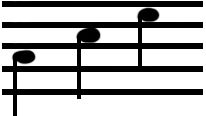It is natural for us to call gestures, as those employed
in 4), or pictures as in 7), elements or instruments of
language.
(We talk sometimes of a language of gestures.)
The pictures in 7) & other instruments of language which
have a similar function I shall call patterns.
(This explanation, as others which we have given, is vague, and
meant to be vague.)
We may say that words and patterns have different kind
s of
functions.
When we make use of a pattern we compare something with it,
e.g.,
12.
a chair with
the picture of a chair.
We did not compare a slab with the word
“slab”.
In introducing the distinction, “word, pattern”, the
idea was not to set up a final logical duality.
We have only singled out two characteristic kinds of instruments from
the variety of instruments in our language.
We shall call “one”, “two”,
“three”, etc. words.
If instead of these signs we used
“-”,
“--”,
“---”,
“----”, we
might call these patterns.
Suppose in a language the numerals were “one”,
“one one”, “one one one”,
etc., should we call “one” a word or a
pattern?
The same element may in one place be used as word & in another
as pattern.
A circle might be the name for an ellipse, or on the other hand a
pattern with which the ellipse is to be compared by a particular method
of projection.
Consider also these two systems of expression:
12). A gives
B an order consisting of two written symbols, the first an
irregularly shaped patch of a certain colour, say
green, the second the drawn outline of a geometrical figure, say a circle.
B brings an object of this outline and that colour, say a
circular green object.
13). A gives B an order
consisting of one symbol, a geometrical figure painted a particular
colour, say a green circle.
B brings him a green circular object.
In 12) patterns correspond to our names of colours and other
patterns to our names of shape.
The symbols in 13) cannot be regarded as combinations of two
such elements.
A word in inverted commas can be called a pattern.
Thus in the sentence, “He said, ‘Go to
hell’”, ‘Go to hell’ is
a pattern of what he said.
Compare these cases:
13.
a) Someone says,
“I whistled … (whistling a
tune)
„ || ”; b)
Someone writes, “I whistled

”.
An onomatopoetic word like “rustling” may be called a
pattern.
We call a very great variety of processes “comparing an object
w
ith a pattern”.
We comprise many kinds of symbols under the name
“pattern”.
In 7) B compares a picture in the table with the objects he
has before him.
But what does comparing a picture with the object consist in?
Suppose the table shewed: a) a picture of a hammer, of
pincers, of a saw, of a chisel; b) on the other hand, pictures
of twenty different kinds of butterflies.
Imagine what the comparison in these cases would consist in, &
note the difference.
Compare with these cases a third case c) where the pictures in
the table represent building stones drawn to scale, & the
comparing has to be done with ruler and compasses.
Suppose that B's task is to bring a piece of cloth of the
colour of the sample.
How are the colours of sample and cloth to be compared?
Imagine a series of different cases:
14). A shews the sample to
B, upon which B goes and fetches the material “from
memory”.
15). A gives B the
sample, B looks from the sample to the materials on the shelves from
which he has to choose.
16). B lays the sample on each
bolt of material & chooses that one which he can't
distinguish from the sample, for which the difference between the sample
& the material seems to vanish.
17). Imagine on the other hand
that the order has been, “Bring a material slightly darker
than this sample”.
In 14) I said
that B fetches the material “from
memory”, which is using a
14.
common form of
expression.
But what might happen in such a case of comparing “from
memory” is of the greatest variety.
Imagine a few instances:
14a). B has a memory image
before his mind's eye when he goes for the
material.
He alternately looks at materials and recalls his image.
He goes through this process with, say, five of the bolts, in some
instances saying to himself, “Too dark”, in some
instances saying to himself, “Too light”.
At the fifth bolt he stops, says, “That's
it”, & takes it from the shelf.
14b). No memory image is
before B's eye.
He looks at four bolts, shaking his head each time, feeling some sort
of mental tension.
On reaching the fifth bolt, this tension relaxes, he nods his head,
& takes the bolt down.
14c). B goes to the
shelf without a memory image, looks at five bolts one after the other,
takes the fifth bolt from the shelf.
“But this can't be all comparing consists
in”.